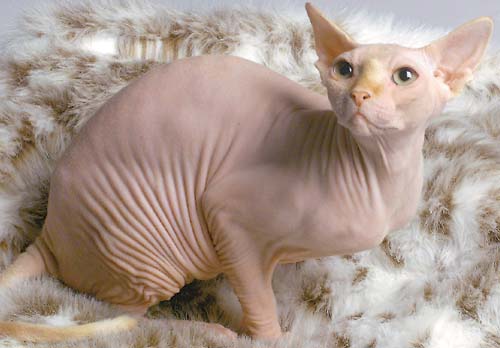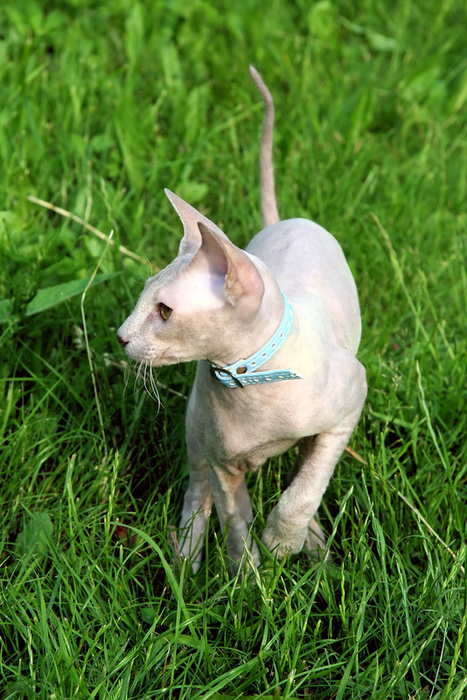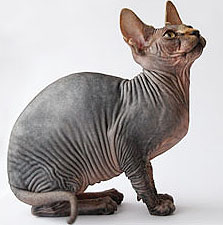



|
Sphynx Description
The Sphynx is a cat surrounded in mystery... much like its namesake. To describe the breed, it is best to begin with its heritage. Hairless, or near hairless, cats have been noted as far back as 1903 where the first record of a hairless cat was noted in Mexico. Over the following decades there were further noted reoccurrence in Morocco, Australia, North Carolina and Canada. It is the occurrence in Canada that is credited by the CFA a with the beginning of the breed, though other hairless kittens discovered at the time have also had much influence. The hairless feature is caused by a recessive gene and requires two copies of the gene to be expressed. In order to keep the gene pool large and the hybrid hearty, those who express the gene are bred with Devon Rex and American ShorthaContrary to what you see when you first look, not all Sphynx are hairless. Most are covered with a soft, down-like fur that gives them the feel of suede laid over a warm water bottle. It is most interesting, however, that an owner need not give up the colorful and diverse colors of regularly coated cats in exchange for the hairlessness of the Sphynx. The breed comes in an astounding 45 colors. Amazing when you consider that some of the felines are, in fact, hairless and the coloring is actually pigmentation variations in the skin. In fact, when exposed to sunlight these colored pigmentation's will darken in almost a tanning effect. It is not, however recommended that they be exposed to extreme amounts of sunlight, heat, or cold. Having a Sphynx is much like having a young child. They do not have the protection of fur to warm them or protect from sunburn.
Despite its hairlessness, the Sphynx is a rather substantial cat with a strong, medium sized body. The breed standard states that the cat should have sturdy bones and good muscle development. A small belly, as though it has just finished eating, is appropriate. Medium legs should be in proportion to the body and end in well-knuckled, oval feet with thick pads giving the impression that the cat is walking on cushions. They are meant to appear wrinkly, wrinkles are good and really, they aren't any more wrinkly than a normal house cat; they simply lack the camouflage of fur. The head is a wedge shape, slightly longer than it is wide, with large ears set neither low nor on top of the head. Eyes are lemon-shaped, tapered at both ends and large. They should be wide set, at least one eye width apart, though color is immaterial in the show ring. A Sphynx should have an open, friendly, and inquisitive look.
Sphynx Temperament
The Sphynx is a winner in the personality department. They love being the center of attention and will perform for their owners in attempts to get it, even behaving clumsily in their antics. They are friendly with other animals but will always prefer the attention of their owners. Sphynx are a high energy breed and are prone to mischief because of this.
Because the cats themselves are the result of a genetic mutation, they are incredibly rare. Most breeders have waiting lists for these amazing animals.
Sphynx Care
The lack of fur on the Sphynx does not make them safe for those with severe allergies. The fur of the cat is not the allergen; it is instead an enzyme, Fel d1. Though the lack of fur certainly helps those with moderate allergies, those with severe allergies should continue to avoid felines as Fel d1 is secreted through saliva and with oils onto the skin of the cat. This same hairlessness also comes with some grooming requirements as allowing the oils to settle on the skin can cause skin problems. Weekly bathing is necessary to keep a Sphynx healthy and happy.
Sphynx History
The Sphynx is a cat surrounded in mystery... much like its namesake. To describe the breed, it is best to begin with its heritage. Hairless, or near hairless, cats have been noted as far back as 1903 where the first record of a hairless cat was noted in Mexico. Over the following decades there were further noted reoccurrence in Morocco, Australia, North Carolina and Canada. It is the occurrence in Canada that is credited by the CFA a with the beginning of the breed, though other hairless kittens discovered at the time have also had much influence. The hairless feature is caused by a recessive gene and requires two copies of the gene to be expressed. In order to keep the gene pool large and the hybrid hearty, those who express the gene are bred with Devon Rex and American Shorthair.
|